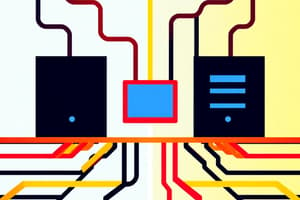Podcast
Questions and Answers
What is a characteristic of a Peer-To-Peer network?
What is a characteristic of a Peer-To-Peer network?
- All computers are connected to a main server.
- Each computer manages itself. (correct)
- It has a centralized system for data backup.
- It requires a dedicated server for security.
What is a disadvantage of a Peer-To-Peer network?
What is a disadvantage of a Peer-To-Peer network?
- It is easy to set up and maintain.
- It requires a dedicated server for performance.
- It has a centralized system for data backup.
- It has a security issue. (correct)
What is the role of a server in a Client/Server network?
What is the role of a server in a Client/Server network?
- To manage its own resources.
- To backup data for other clients.
- To manage all the resources such as files, directories, and printer. (correct)
- To communicate with other clients directly.
What is an advantage of a Client/Server network?
What is an advantage of a Client/Server network?
What is a disadvantage of a Client/Server network?
What is a disadvantage of a Client/Server network?
How do clients communicate with each other in a Client/Server network?
How do clients communicate with each other in a Client/Server network?
What is a benefit of having a centralized system in a Client/Server network?
What is a benefit of having a centralized system in a Client/Server network?
What is a characteristic of a Client/Server network?
What is a characteristic of a Client/Server network?
What is the primary function of the Data Link layer?
What is the primary function of the Data Link layer?
What is the main responsibility of the Network layer?
What is the main responsibility of the Network layer?
Which layer is responsible for routing and forwarding packets?
Which layer is responsible for routing and forwarding packets?
What is the process of adding source and destination addresses to the header of the frame called?
What is the process of adding source and destination addresses to the header of the frame called?
What is the primary function of the Transport layer?
What is the primary function of the Transport layer?
What is the term used to describe the process of breaking down data into packets?
What is the term used to describe the process of breaking down data into packets?
What is the main responsibility of a router?
What is the main responsibility of a router?
What is the term used to describe the process of connecting multiple devices on the same network?
What is the term used to describe the process of connecting multiple devices on the same network?
What is the frequency range of a twisted pair cable?
What is the frequency range of a twisted pair cable?
What determines the degree of reduction in noise interference in a twisted pair?
What determines the degree of reduction in noise interference in a twisted pair?
What is the maximum data rate that Category 5 unshielded twisted pair can support?
What is the maximum data rate that Category 5 unshielded twisted pair can support?
What is the main disadvantage of unshielded twisted pair?
What is the main disadvantage of unshielded twisted pair?
What is the main characteristic of shielded twisted pair?
What is the main characteristic of shielded twisted pair?
What is the main advantage of unshielded twisted pair?
What is the main advantage of unshielded twisted pair?
What is the main disadvantage of shielded twisted pair?
What is the main disadvantage of shielded twisted pair?
What is the main difference between unshielded twisted pair and shielded twisted pair?
What is the main difference between unshielded twisted pair and shielded twisted pair?
What is the frequency range of terrestrial microwave?
What is the frequency range of terrestrial microwave?
What is the main advantage of using microwave transmission over cables?
What is the main advantage of using microwave transmission over cables?
What is the main limitation of microwave transmission?
What is the main limitation of microwave transmission?
What happens to the signal when it is transmitted using microwave transmission?
What happens to the signal when it is transmitted using microwave transmission?
What is the main advantage of using satellite communication?
What is the main advantage of using satellite communication?
What is the main function of a satellite in satellite communication?
What is the main function of a satellite in satellite communication?
What is the main limitation of satellite communication?
What is the main limitation of satellite communication?
What is the main concern of microwave transmission?
What is the main concern of microwave transmission?
What is the main purpose of multiplexing?
What is the main purpose of multiplexing?
What is the device used for demultiplexing?
What is the device used for demultiplexing?
What is the principle behind multiplexing?
What is the principle behind multiplexing?
What is the result of multiple signals sharing a common medium without multiplexing?
What is the result of multiple signals sharing a common medium without multiplexing?
Who developed the telephone carrier multiplexing?
Who developed the telephone carrier multiplexing?
What is the output of a multiplexer?
What is the output of a multiplexer?
In what year did multiplexing originate in telegraphy?
In what year did multiplexing originate in telegraphy?
What is the effect of multiplexing on transmission services?
What is the effect of multiplexing on transmission services?
Flashcards are hidden until you start studying
Study Notes
Peer-to-Peer Network
- In a peer-to-peer network, if one computer stops working, the others will not be affected.
- Each computer manages itself, making it easy to set up and maintain.
- Disadvantages include:
- No centralized system for data backup.
- Security issues since each device manages itself.
Client/Server Network
- A client/server network is designed for end users (clients) to access resources from a central computer (server).
- The server manages all resources, including security and network management.
- Clients communicate with each other through the server.
- Advantages include:
- Centralized system for data backup.
- Improved performance and security.
- Faster resource sharing.
- Disadvantages include:
- High cost of the server and its operating system.
- Requires a dedicated server with large memory.
Network Layer (Layer 3)
- Manages device addressing and tracking.
- Determines the best path for data transmission based on network conditions and priority.
- Responsible for routing and forwarding packets.
- Routers are layer 3 devices used for routing services.
- Protocols used for routing include IP and IPv6.
- Functions include:
- Internetworking: connecting different devices.
- Addressing: adding source and destination addresses to packets.
- Routing: determining the best path for data transmission.
- Packetizing: dividing data into packets.
Transport Layer (Layer 4)
- Ensures that messages are transmitted in the correct order and without duplication.
- Responsible for complete data transfer.
- Provides error-free transfer of data.
Guided Media
- Types:
- Twisted Pair:
- Made up of two insulated copper wires twisted together.
- Categories: 1, 2, 3, 4, 5, with increasing speeds.
- Advantages: cheap, easy to install, lightweight.
- Disadvantages: limited distance due to attenuation.
- Shielded Twisted Pair (STP):
- Has a mesh surrounding the wire for higher transmission rates.
- Advantages: higher capacity, easier to install, shielded.
- Disadvantages: more expensive than UTP.
- Twisted Pair:
Microwave
- Frequency range: 4-6 GHz to 21-23 GHz.
- Bandwidth: 1-10 Mbps.
- Short distance: inexpensive.
- Long distance: expensive due to tower requirements.
- Attenuation: affected by environmental conditions and antenna size.
- Advantages:
- Cheaper than cable transmission.
- No land acquisition required.
- Easy communication in terrains.
- Communication over oceans possible.
- Disadvantages:
- Susceptible to eavesdropping.
- Out of phase signal.
- Weather conditions affect signal.
- Limited bandwidth.
Satellite Microwave Communication
- A satellite is a physical object that revolves around the earth.
- Satellite communication is more reliable and flexible than cable and fiber optic systems.
- How it works:
- Signal is transmitted from earth station to satellite.
- Satellite amplifies the signal.
- Multiplexing is used to combine multiple data streams.
- Signal is transmitted back to earth station.
- Multiplexing:
- Why: to avoid collision and share bandwidth.
- Concept: combining multiple signals into one.
- History: originated in telegraphy in the 1870s.
- Types: many-to-one, one-to-many.
Studying That Suits You
Use AI to generate personalized quizzes and flashcards to suit your learning preferences.




